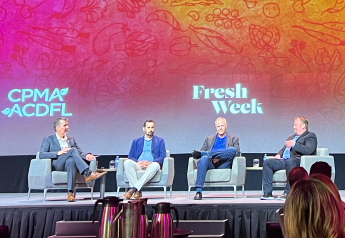Looking ahead to grapes — Pricing and availability information

Editor's note: This information is contributed by Mike Mauti, managing partner of consulting firm Execulytics. The company’s signature product is the Produce Almanac, which provides seasonality and cost information on all the major fresh produce commodities. You can reach Mike at mike@execulytics.ca
Conventional availability and seasonality
Quarter 1
Available out of Chile and Peru at ports of entry. Packed in 18-pound cartons, average f.o.b. costs are normally in the mid to high $20s to begin the quarter, dropping to the mid- to high teens in March. Each size larger runs a $1-$2 premium. Different varieties run different costs depending on volumes, but expect the newer, high-flavor varieties to be more expensive.
Quarter 2
Available out of Chile at ports of entry to start, then transitioning to Mexico through Arizona and California towards the end. Packed in 18-pound cartons, transitioning to 19-pound, the average f.o.b. costs tend to spike into the twenties early in the quarter. In 2019 costs increased until the start of Mexico, when costs declined into the low to mid-teens. Larger grape sizes carry a premium.
Quarter 3
Product of Mexico finishes, and grapes enter prime time with product from California. Packed in 19-pound cartons. Varieties start and stop all season but mostly trade in the high teens, normally declining throughout the quarter. There is an approximate $3 premium for large over medium fruit.
Quarter 4
California is the main source in Q4. F.o.b. costs begin to rise into the low to mid- $20s as the season starts to wind down. While all colors are available, some varieties command a premium, as does larger sizing. By mid-December, 18-pound Peruvian product becomes available. F.o.b. costs are normally in the $30s, with a premium on larger fruit and no pattern of differences between red and green varieties.
Sales Opportunities
Opportunities to push grape sales are best in the summer and fall months. Because varieties are often finishing as other varieties are starting, there are frequent opportunities with lower-cost fruit on the varieties that are finishing. These opportunities can offer fruit at approximately $0.75-$0.85 per pound f.o.b. There are many new flavorful grape varieties that can breathe new life into this traditional category. Find several to designate as signature varieties for your grape operations.
Related: Grape expectations — Suppliers talk varieties, packaging, season
Organic versus conventional availability
Organic seedless grapes are generally available in June from Mexico, crossing through Arizona packed in 18-pound cartons, and from California between mid-July and December in 19-pound cartons. Product can come in either bags or clamshells. Red, green and black varieties are all available, typically in the larger grape sizes.
Costing
F.o.b. costs for organic grapes very much mirror the conventional program when they are available. F.o.b. costs are fairly stable, remaining in the mid-$20s most of the season, but may increase as the California season comes to an end. There are few differences in cost between varieties or sizes when more than one of either is available at the same time.
The organic premium averages approximately 40% to conventional over the whole season, representing less than $0.50 per pound, and this remains more or less constant all year. However, like many categories, there may be times when organic approaches parity with conventional, like it did in June of 2019.
Sales opportunities
Organic seedless grapes are available in the back half of the year. The best time to push for sales is in the late spring during the late Mexican season. It is possible to find organic at premiums of less than $0.20 per pound f.o.b. Starting in late summer and extending through the fall, California product offers a secondary opportunity, with organic premiums between $0.40 and $0.50 per pound f.o.b.







